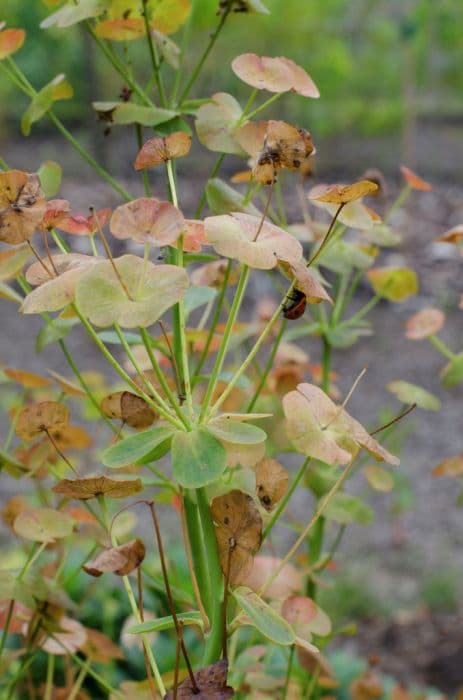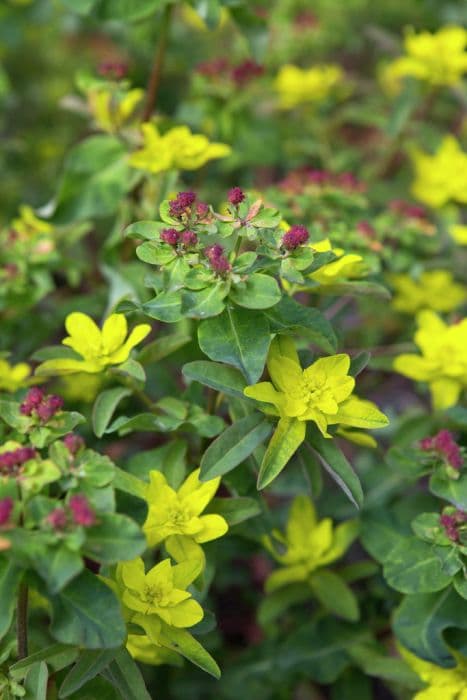Chameleon Spurge Euphorbia dulcis 'Chameleon'

ABOUT
Euphoria dulcis 'Chameleon', commonly known as Sweet Spurge 'Chameleon', is a striking perennial plant noted for its vivid foliage which changes color with the seasons. At first glance, the leaves capture attention with their mottled appearance, featuring a mix of green, purple, bronze, and bright fiery hues that can include reds and oranges. This intricate tapestry of colors makes it a popular choice for adding visual interest to gardens. In spring, the fresh new growth may start as a light green or yellow, progressing to deeper tones as the days grow warmer. During the summer months, the foliage intensifies, showcasing darker shades of purple and bronze that stand out in contrast to the softer greens of neighboring plants. It is during the fall that the 'Chameleon' truly lives up to its name, as the leaves often transition to a bold reddish-purple hue, providing a spectacular display against the autumn landscape. Sweet Spurge 'Chameleon' bears clusters of small, inconspicuous flowers, which are typically surrounded by showy bracts that can sometimes match the dramatic colors of the leaves. These blooms can add a delicate texture to the plant's robust foliage. While the flowers may not be the main attraction, they do contribute to the overall allure of the plant throughout its blooming season. The growth habit of Sweet Spurge 'Chameleon' is compact and bushy, with a tendency to form a rounded or mounding shape. Its stems are slender and may also display hints of color that echo the tones found in the leaves. This plant can be particularly effective when used as a ground cover or as a charming accent in mixed borders, where its color-changing leaves can be appreciated up close.
About this plant
 Names
NamesSynonyms
Sweet Spurge, Chameleon Spurge, Chameleon Plant
Common names
Euphorbia dulcis 'Chameleon'
 Toxicity
ToxicityTo humans
Spurge is known for its toxic sap, which can cause skin irritation and inflammation upon contact. If ingested by humans, the sap from spurge can lead to nausea, vomiting, and diarrhea. The severity of these symptoms can vary from person to person, but it is essential to avoid ingesting any part of the plant to prevent these potential adverse health effects.
To pets
Spurge is also toxic to pets and can cause similar symptoms as in humans if ingested. The milky sap can irritate the mouth and stomach, leading to symptoms like drooling, vomiting, and diarrhea. In severe cases, ingestion can lead to more serious gastrointestinal issues. It is important to prevent pets from chewing on or ingesting any part of the spurge plant to avoid these toxic effects.
 Characteristics
CharacteristicsLife cycle
Perennials
Foliage type
Deciduous
Color of leaves
Varies
Flower color
Yellow-green
Height
1-2 feet (30-60 cm)
Spread
1-2 feet (30-60 cm)
Plant type
Herb
Hardiness zones
4-9
Native area
Europe
Benefits
 General Benefits
General Benefits- Attractive Foliage: Euphorbia dulcis 'Chameleon' boasts colorful foliage that changes from green to shades of purple, red, and bronze throughout the season, adding visual interest to the garden.
- Drought Tolerance: As a member of the Euphorbia family, this plant is relatively drought-tolerant once established, making it suitable for xeriscaping and water-wise gardens.
- Low Maintenance: This species typically requires minimal care, thriving in a variety of conditions without needing frequent watering, pruning, or fertilization.
- Pest Resistance: The Euphorbia dulcis 'Chameleon' is known to be resistant to many common garden pests, reducing the need for chemical treatments.
- Adaptability: It adapts well to a range of soil types, although it prefers well-drained soil, and can tolerate partial shade to full sun environments.
- Seasonal Interest: The plant provides year-round interest with its changing foliage colors and prominent, long-lasting flower bracts that appear in the spring and early summer.
- Erosion Control: Its root system helps stabilize soil, making it a good choice for slopes or areas prone to erosion.
- Versatility: It can be used in borders, rock gardens, and as ground cover, offering flexibility in landscape design.
- Non-Invasive: Unlike some other Euphorbia species, Euphorbia dulcis 'Chameleon' does not aggressively spread, making it a neighbor-friendly garden choice.
- Pollinator Attraction: While it's not particularly known for attracting a wide range of pollinators, it can still draw in bees and butterflies, contributing to the health of the local ecosystem.
 Medical Properties
Medical PropertiesThis plant is not used for medical purposes.
 Air-purifying Qualities
Air-purifying QualitiesThis plant is not specifically known for air purifying qualities.
 Other Uses
Other Uses- The Spurge 'Chameleon' can be used in container gardening for its striking foliage that adds contrast to floral arrangements.
- Spurge 'Chameleon' serves as a colorful ground cover that changes hues with the seasons, ideal for creating visually dynamic landscapes.
- The plant can be used as a natural dye, providing various shades of yellow to green, depending on the mordant used.
- In frost-free regions, Spurge 'Chameleon' can be used to create permanent outdoor tapestries in rockeries or gravel gardens, where it thrives with minimal maintenance.
- Spurge 'Chameleon' works well in a butterfly garden, as its flowers attract a variety of pollinators, contributing to the garden's ecosystem.
- The foliage of Spurge 'Chameleon', due to its toxicity, can act as a deterrent for certain pests in the garden, offering a form of natural pest control.
- When carefully handled, its distinctive, colorful foliage can be used in dried flower arrangements for long-lasting decor.
- Spurge 'Chameleon' can be a teaching tool for botany enthusiasts, especially to demonstrate plant adaptability and color variation within species.
- It can be used in ecological landscaping practices, as it is resilient, low maintenance, and adaptable to a variety of soil types.
- By carefully positioning Spurge 'Chameleon' in the garden, one can use its reflective foliage to subtly enhance nighttime garden aesthetics when illuminated by garden lights.
Interesting Facts
 Feng Shui
Feng ShuiThe Spurge is not used in Feng Shui practice.
 Zodiac Sign Compitability
Zodiac Sign CompitabilityThe Spurge is not used in astrology practice.
 Plant Symbolism
Plant Symbolism- Adaptability: The name 'Chameleon' suggests the plant's ability to change and adapt to its surroundings, similar to a chameleon changing its color.
- Resilience: Euphorbia plants, in general, are known for their hardiness and ability to thrive in tough conditions, symbolizing resilience and perseverance.
- Unique Beauty: The distinctive color-changing foliage of 'Chameleon' symbolizes uniqueness and the beauty of being different.
 Water
WaterSweet Spurge, commonly known as Euphorbia Dulcis 'Chameleon', should be watered deeply but infrequently, allowing the soil to dry out slightly between watering. Typically, watering once a week with one to two gallons of water is adequate. During the warmer months, you may need to water more often to maintain consistent soil moisture. Reduce the frequency of watering during the winter when the plant is dormant. It's crucial to avoid waterlogging, as this can lead to root rot in the plant.
 Light
LightSweet Spurge thrives best in full sun to partial shade conditions. An ideal spot for Euphorbia Dulcis 'Chameleon' would be a location where it receives several hours of direct sunlight daily, but is protected from the harsh afternoon sun. Providing bright, indirect light will help maintain the vibrant foliage colors.
 Temperature
TemperatureSweet Spurge prefers a temperature range of 50 to 75 degrees Fahrenheit and can tolerate a minimum temperature of around 30 degrees Fahrenheit. The ideal growing conditions for Euphorbia Dulcis 'Chameleon' are in an environment where temperatures are consistent and do not fluctuate dramatically, especially avoiding frost conditions which can damage the plant.
 Pruning
PruningPruning Sweet Spurge can help maintain its shape and encourage denser growth. Euphorbia Dulcis 'Chameleon' should be pruned in late winter or early spring before new growth begins. Remove any dead or damaged stems, and cut back up to a third of the plant to stimulate new growth. Pruning should be done annually or as needed to control the size and appearance of the plant.
 Cleaning
CleaningAs needed
 Soil
SoilSpurge 'Chameleon' thrives in well-draining soil with a mixture of potting soil, peat, and perlite or sand. The ideal soil pH for Spurge 'Chameleon' is slightly acidic to neutral, ranging from 6.0 to 7.0.
 Repotting
RepottingSpurge 'Chameleon' generally needs repotting every 2-3 years or when it outgrows its pot. It's best to repot in the spring to give the plant time to establish.
 Humidity & Misting
Humidity & MistingSpurge 'Chameleon' prefers moderate humidity levels but is quite adaptable and can tolerate a wide range of humidity conditions frequently found in average home or garden environments.
 Suitable locations
Suitable locationsIndoor
Position Spurge 'Chameleon' in bright light avoiding direct sun.
Outdoor
Plant in partial shade, well-draining soil.
Hardiness zone
6-9 USDA
 Life cycle
Life cycleThe life of the Spurge 'Chameleon' (Euphorbia dulcis 'Chameleon') begins with seed germination, which occurs in warm, moist soil conditions typically in spring. Following germination, seedlings emerge and develop a root system and foliage. As the plant matures, it forms a clump of reddish-purple leaves, and in late spring to early summer, it produces small, greenish-yellow flowers. After pollination, which is often facilitated by insects, the plant develops seed pods that eventually burst to release seeds. Throughout the growing season, Spurge 'Chameleon' may also spread vegetatively through its rhizomatous root system. Heading into dormancy during winter, the above-ground foliage dies back, while the roots remain alive to regenerate the following spring.
 Propogation
PropogationPropogation time
Early Spring
The most popular method of propagation for Euphorbia dulcis 'Chameleon', commonly known as Spurge, is through division. This is best done in the spring when the plant is emerging from dormancy. Carefully dig up the entire plant, making sure to get as much of the root mass as possible. Gently separate the plant into smaller sections, each with a portion of root and several shoots. These sections can then be replanted immediately at the same depth they were growing at before, spacing them about 12 inches (approximately 30 centimeters) apart to allow for growth. Water the new plantings thoroughly to help establish them. Division not only helps propagate Spurge but also rejuvenates older plants that may have become woody or overgrown.



![Spurge [Silver Swan]](/_next/image?url=https%3A%2F%2Fplants-admin.emdemapps.com%2Fimages%2Fplants%2F%2Fimages%2F604b573f6c8f6.png&w=640&q=75)





